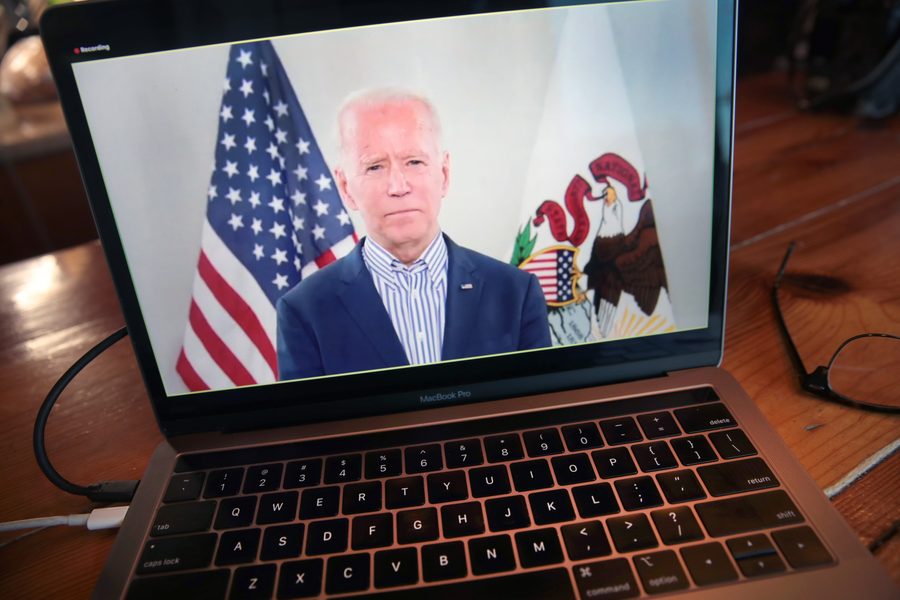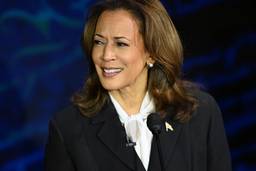What’s Joe Biden’s Response to Coronavirus? Even He Doesn’t Seem Sure.
Biden’s coronavirus response plan doesn’t just fall short—it also doesn’t match what he’s been telling the public.
Branko Marcetic

Joe Biden needs two things to beat Trump in a general election: to win over young people, and to develop an effective and consistent response to the current coronavirus crisis. He’s failing on both.
Throughout his infrequent public appearances over the last few weeks — at his March 12 press conference and the March 15 Democratic debate, for instance — Biden has tended to avoid outlining specific proposals for dealing with the coronavirus crisis. Instead, he points people to Joebiden.com, to read the nearly 7,000-word plan his campaign first released weeks ago. Even the release of an updated plan on March 26 has not adequately made his approach clear.
Within the first five minutes of his major March 23 address, his first public appearance in nearly a week while the crisis worsened, Biden directed viewers to read that “very detailed, in-depth plan,” opting to talk about only a few aspects of it. When jokingly asked by talk show host Jimmy Kimmel on March 26 if he had thought about calling Trump to advise him, Biden replied that “all kidding aside,” the two-week-old plan had “laid out in detail what I thought had to be done.”
In other words, Biden clearly views this plan as essential for understanding how he plans to respond to the crisis should he win the presidency. And yet there are numerous discrepancies between the plan and what Biden’s been telling audiences.
Take the Defense Production Act, the Korean War-era law that allows the federal government to direct the production of essential resources by the private sector during emergencies. Biden has urged Trump to use it to “radically increase the supply of critical goods needed to treat patients and protect our healthcare workers and first responders,” and “build a medical arsenal.” On Tuesday, he told MSNBC he had called for its use “a while ago,” and told CNN that it “should’ve been enacted months ago,” and that he called on Trump to enact it “two, three weeks ago.” Laying out his “detailed plan” to Kimmel, Biden said that “for example, I call for the Defense Production Act to be used,” before trailing off, seemingly unable to recall other specifics.
Biden is right that Trump has dithered on using the wartime law, invoking the act but declining, for explicitly ideological reasons, to use it to direct private-sector production. But Biden’s push for its use appears to be a relatively recent strategy.
The Defense Production Act wasn’t mentioned in the first version of Biden’s plan, which instead talked about “work[ing] with businesses to expand production of personal protective equipment” and to “incentivize greater supplier production of these critically important medically [sic] supplies.” In fact, Biden first called on Trump to invoke it only on March 18, 19 days after Health and Human Services Secretary Alex Azar first floated the idea and minutes after Trump had already announced he was partially invoking it. (Democratic rival Sen. Bernie Sanders only just beat Biden, calling for the law’s invocation on March 17).
Biden is also sending mixed signals on how far he is willing to go in terms of government spending. A lifelong deficit hawk who voted for a balanced budget constitutional amendment three years in a row, Biden’s plan nonetheless states he “believes we must spend whatever it takes, without delay, to meet public health needs and deal with the mounting economic consequences,” a line he repeated in his March 12 speech. Though the plan doesn’t specify the cost of any of its proposals, these lines seem to imply a rejection of peacetime spending limits in the face of an emergency.
Yet Biden has since given a different impression. Speaking about a possible Main Street bailout package a few days later at the Democratic debate, Biden said that “the problem is, the policies of this administration economically have … we’ve eaten a lot of our seed corn here. The ability for us to use levers that were available before have been used up by this godawful tax cut of $1.9 trillion.”
Last Monday, Biden called for “keep[ing] everyone paid through this crisis … while still protecting the American taxpayers.” Such language doesn’t suggest the kind of limitless spending in the face of crisis promised in his plan. And while a Biden administration could conceivably give itself more room to maneuver by raising taxes, Biden has rejected the wealth taxes favored by Sanders and Elizabeth Warren and plans to bring in six times less revenue than either of them.
It’s also not exactly clear what form of economic assistance Biden is envisioning. In his public appearances, Biden tends to speak in generalities. In his March 12 speech, he called for “immediate bold measures to help Americans who are hurting economically,” and “relief that will be large in scale focused on broader health and stability of our economy.” “We should be doing everything in our power to keep workers on payrolls, make small businesses healthier, help the economy come out on the other side strong,” he said last Monday, calling for the federal government to “provide the resources to make that happen.” The government should “take care of those people who are in desperate need now,” he told MSNBC, later reiterating to CNN’s Jake Tapper that the government “make sure that they are not going without the economic means that are necessary to keep their households moving.”
When he did drill down to specifics, Biden initially called for emergency expansion of paid sick leave and unemployment insurance, in addition to permanent paid sick leave. But as the scale of the crisis has grown, he seems to have become more vocal about bolder measures. “We have to put a freeze on evictions, we gotta put a freeze on mortgage payments,” he told The View on March 24, adding that the government “rush monies to people and small businesses and others that need it now.” “Cash relief needs to go out as fast as possible to those who need it the most,” he said a day earlier.
Yet cash payments have barely featured in Biden’s plan. Their only mention is in the section covering Biden’s State and Local Emergency Fund, a fund of indeterminate size that gives mayors and governors, not the federal government, the “flexibility” to decide how to respond to the crisis.
“Where governors and mayors determine it is necessary to adequately address the full range of economic pain created by the COVID-19, the fund will authorize such leaders to directly draw on it to implement broader progressive cash or tax relief,” the plan states. “That could include cash payments to working families, unpaid caregivers, seniors, those with disabilities, and children, or a child allowance. It could also be used to fund new legislation to expand State Earned Income Tax Credit relief.”
In other words, under a Biden presidency, state and local governments can decide whether they want to send checks to families, which people they think deserve to get this money, or if they’d prefer to just turn the money into tax break instead — and even then, only if they “determine it necessary.”
On the other hand, Biden is supporting the coronavirus emergency bill that has been the subject of days of congressional wrangling, including its provisions of direct checks of $1,200 per American making less than $75,000 a year, and $500 per child. Biden has cautioned that “it’s not everything that I would want,” and indeed, these provisions have come under heavy criticism from progressives. Not only does the bureaucracy involved mean the payments will come far too late for many families, but the means-tested, one-time sum of $1,200 falls far short of the proposals for universal payments of $2,000 a month per family for the duration of the crisis, $1,000 a month per American until a year after the crisis is over following an initial payment of $2,000, and $2,000 a month per adult and $1,000 per child, all respectively proposed by progressives like Sanders, Rep. Rashida Tlaib (D-MI), and Rep. Maxine Waters (D-CA).
Does Biden prefer a larger payment? If so, how much larger? Would it be means-tested or universal? Would it be a one-time check or continuous? How does he feel about the potentially months-long delay involved? And does he still prefer to devolve power to state and local governments to distribute this money?
Biden himself hasn’t clarified. His defenders say he’s trying not to step on Democrats’ toes during negotiations; yet as the prospective nominee, not only is he meant to be setting the party’s agenda, but he should also be putting forward ideas that will compete against Trump come the general election, who has improbably ridden his catastrophically bungled response to the crisis to his best-ever approval ratings.
Biden’s approach to mortgages and evictions faces similar confusion. Contrary to his statement on The View, there is no eviction freeze laid out in Biden’s plan. Rather, he leaves it up to governors and mayors to draw on the Emergency Fund “to implement rental assistance, no-interest forbearance or mortgage payment relief.”
There is an added risk to Biden’s delegation of responsibility to mayors and governors when it comes to cash payments, and rent and mortgage relief. Such discretion potentially puts millions of Americans at the mercy of conservative, science-denying governments at the state and local level, who may prefer not to give what they see as handouts to workers they believe should be risking their lives and going to work. These are governments like that of Mississippi Gov. Tate Reeves, who recently rejected calls to lock down his state amidst rising Covid-19 cases because “Mississippi’s never going to be China.” Or they may be one of the 14 states that have still not expanded Medicaid since the passage of the Affordable Care Act ten years ago.
Biden’s Second Plan
Biden’s team has since released an additional plan on March 26, this one focused on how “to save our economy and help our families weather the storm.” Leading with the Defense Production Act, it’s a three-point proposal whose second plank is a task force to impose oversight on the relief money being spent by the federal government, and the third “bring[ing] the leaders of Congress together to build the next deal.”
There are appealing specifics in the campaign’s new plan. It calls for Biden’s scaled-back student loan forgiveness, and an increase of Social Security checks by $200 a month, a concrete number attached to his platform’s vow to increase benefits for older Americans. But these are not new ideas for the Biden team. His demands for emergency paid sick leave, free coronavirus testing and treatment and a free vaccine are likewise reiterations of demands made in the first plan.
Like the first version of the plan, Biden continues to encourage “work-sharing,” an Obama-era policy championed by left-leaning think-tanks like the Center for American Progress and the Center for Economic and Policy Research. Broadly speaking, the policy incentivizes employers to keep workers on their payrolls by reducing work hours, helping to keep unemployment rates low. The idea only gets one brief line in the latest iteration, however. It’s also unclear how much of an impact it would have in the current crisis, when millions are losing jobs because many businesses aren’t physically able to stay open for public health reasons.
Biden’s other demands throughout this latest plan are similarly vague. They include “additional checks to families should conditions require” on top of the one-time $1,200 payment passed by Congress, without any detail beyond that. The plan promises to “cut through the red tape” to deliver unemployment insurance “without delay,” but with state unemployment websites crashing across the country, it doesn’t specify how. Biden would “would tell large companies seeking taxpayer assistance that they need to make hard commitments” not to misuse that money, the plan tells us, and otherwise “hold the strictest line on bans on buybacks and raises for executives,” “impose the highest scrutiny on payroll plans,” and “not let companies off the hook.”
What that means in practice is left up to the reader’s imagination.
While finally including the Defense Production Act that was left out of the original, there are still things missing. Through promising “all necessary fiscal relief to states,” the plan doesn’t clarify if Biden is sticking by his original idea of letting state and local governments decide how to bail out working Americans. Nor does it make any mention of the eviction freeze Biden has touted in interviews.
Since its release, Biden has again gotten ahead of his own plan in interviews. In a CNN town hall last Friday, asked by a viewer about a rent freeze, Biden said he would “freeze it and forgive it,” citing the time span of “at least the next three months.” Asked by Anderson Cooper if he would support moratoriums on utility shut-offs, he answered: “Absolutely. I’d do it nationwide.” Neither a rent freeze nor a utility shut-off moratorium appears in either of Biden’s plans so far. The campaign made sure to add Biden’s recent call for forgiving at least $10,000 in student debt into his latest plan; why hasn’t it done so for these policies?
Adding to the confusion, Biden hasn’t referenced his March 26 proposal in any of the public appearances he’s done since its release. In fact, the day it came out, he was still referring Jimmy Kimmel to his original, two-week-old plan. With discrepancies between the two, as well as with Biden’s own public statements, it’s not clear where a public wondering what Biden would do as president should be looking.
Lagging behind
Much of this points to a larger problem that Biden’s campaign will need to overcome to both establish itself as a leader on the coronavirus response, as well as win over young voters. From the beginning, Biden has lagged behind the party’s leading progressive and youth-oriented voices, and even some Republicans. When Biden was only calling for emergency paid sick leave, Sanders was already calling for a moratorium on evictions, foreclosures and utility shut-offs.
The cash payment proposal Biden backs falls far short of progressive demands. He hasn’t gone nearly as far as Waters, for instance, who is calling for a suspension of all credit payments (including credit cards and personal loans), credit reporting, debt collection and repossession.
And while his plan calls for “eliminating cost barriers for prevention of and care for COVID-19,” he hasn’t gone as far as Rep. Ilhan Omar (D-MN), who is calling for all private hospitals to be temporarily nationalized as has been done in Spain and Ireland, or Sanders, who is calling for emergency universal health care for the duration of the crisis. Both proposals are vital at a time when jobless claims rose more than 3 million in the space of a week, meaning potentially millions of Americans were thrown off their health insurance — a problem neither Biden’s plan nor Biden himself is yet offering a solution to.
Biden’s inability to respond to this particular issue was shown in CNN’s town hall. A viewer who was likely infected with coronavirus complained about the lack of availability of testing and described her struggles with the private insurance system: her small employer didn’t provide health benefits, so she paid $2,000 a month for insurance. She wondered what she would do when her savings finally ran out.
Biden’s response, while asserting she “should not have to sacrifice anything,” entirely skipped over her dilemma: He told her three times that testing should be free, said she would be covered by the expanded unemployment insurance in the latest coronavirus bill, and called for Republicans to drop their lawsuit against Obamacare. When Cooper pointed out mass lay-offs also meant the loss of health insurance for many, Biden continued to tout his public option plan that preserves employer insurance, which he asserted would “cost close to a billion dollars” — $749 billion less than the estimate from his own campaign.
The Biden campaign did not respond to an emailed list of questions seeking clarification on all of these matters.
A progressive response
The Biden campaign should clarify its candidate’s stances on matters like cash payments and eviction and rent freezes, and reconcile the differences between the two plans it’s put out. As is, the gulf between Biden’s public statements and the content of the plan he continues directing people to read is confusing — and that’s not even including the addition of a second plan. At best, it creates the impression Biden isn’t aware of what’s in his own plan; at worst, it makes him appear to be cynically adopting multiple positions.
Secondly, if Biden wants to win over young voters, the best way to do that is to sincerely adopt the ideas being pushed by the politicians most popular among them, such as Sanders, Tlaib and Omar. A watered-down student debt forgiveness plan isn’t going to cut it, and neither will virtual roundtables whose function is to make Biden seem relatable, with a few words of sympathy for the struggles facing young people thrown in.
But to do this, Biden will have to compromise his career-long aversion to big-spending government programs. Just as he “became more and more a believer in balanced budgets” over the course of the 1970s and 1980s due to that era’s shift in politics, Biden must now catch up as politics moves rapidly in the opposite direction. He must abandon his career-long war on government spending and federal programs, and embrace big government and deficit spending. Doing so can make him appear both a leader in this crisis, and win over the young voters he so desperately needs. The question is, after a lifetime of doing the opposite, and a year of courting well-heeled donors, can he bring himself to do it?
Branko Marcetic is a staff writer at Jacobin magazine and a 2019-2020 Leonard C. Goodman Institute for Investigative Reporting fellow. He is the author of Yesterday’s Man: The Case Against Joe Biden.








